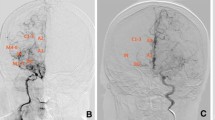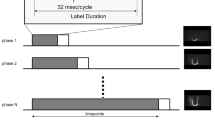Abstract
Objectives
To evaluate the performance of four-dimensional pseudo-continuous arterial spin labeling (4D-pCASL)-based angiography using CENTRA-keyhole and view sharing (4D-PACK) in the visualization of flow dynamics in distal cerebral arteries and leptomeningeal anastomosis (LMA) collaterals in moyamoya disease in comparison with contrast inherent inflow-enhanced multiphase angiography (CINEMA), with reference to digital subtraction angiography (DSA).
Methods
Thirty-two cerebral hemispheres from 19 patients with moyamoya disease (mean age, 29.7 ± 19.6 years; five males, 14 females) underwent both 4D-MR angiography and DSA. Qualitative evaluations included the visualization of anterograde middle cerebral artery (MCA) flow and retrograde flow via LMA collaterals with reference to DSA. Quantitative evaluations included assessments of the contrast-to-noise ratio (CNR) on these vessels. The linear mixed-effect model was used to compare the 4D-PACK and CINEMA methods.
Results
The vessel visualization scores were significantly higher with 4D-PACK than with CINEMA in the visualization of anterograde flow for both Observer 1 (CINEMA, 3.53 ± 1.39; 4D-PACK, 4.53 ± 0.80; p < 0.0001) and Observer 2 (CINEMA, 3.50±1.39; 4D-PACK, 4.31 ± 0.86; p = 0.0009). The scores were higher with 4D-PACK than with CINEMA in the visualization of retrograde flow for both Observer 1 (CINEMA, 3.44 ± 1.05; 4D-PACK, 4.47 ± 0.88; p < 0.0001) and Observer 2 (CINEMA, 3.19 ± 1.20; 4D-PACK, 4.38 ± 0.91; p < 0.0001). The maximum CNR in the anterograde flow was higher in 4D-PACK (40.1 ± 16.1, p = 0.0001) than in CINEMA (27.0 ± 16.6). The maximum CNR in the retrograde flow was higher in 4D-PACK (36.1 ± 10.0, p < 0.0001) than in CINEMA (15.4 ± 8.0).
Conclusions
The 4D-PACK provided better visualization and higher CNRs in distal cerebral arteries and LMA collaterals compared with CINEMA in patients with this disease.
Key Points
• The 4D-PACK enables good visualization of distal cerebral arteries in moyamoya disease.
• The 4D-PACK enables direct visualization of leptomeningeal collateral vessels in moyamoya disease.
• Vessel visualization by 4D-PACK can be useful in assessing cerebral hemodynamics.






Similar content being viewed by others
Abbreviations
- 4D-PACK:
-
Four-dimensional pseudo-continuous arterial spin labeling-based angiography using CENTRA-keyhole and view sharing
- 4D:
-
Four dimensional
- AccASL:
-
Acceleration-selective ASL
- CBF:
-
Cerebral blood flow
- CENTRA:
-
Contrast-enhanced timing-robust angiography
- CINEMA:
-
Contrast inherent inflow-enhanced multiphase angiography
- CNR:
-
Contrast-to-noise ratio
- DSA:
-
Digital subtraction angiography
- EPI:
-
Echo planer imaging
- ICA:
-
Internal carotid artery
- LMA:
-
Leptomeningeal anastomosis
- MCA:
-
Middle cerebral artery
- MIP:
-
Maximum intensity projection
- PCA:
-
Posterior cerebral artery
- pCASL:
-
Pseudo-continuous arterial spin labeling
- RF:
-
Radiofrequency
- ROI:
-
Region of interest
- ST:
-
Stationary tissue
- TOF:
-
Time of flight
References
Suzuki J, Takaku A (1969) Cerebrovascular "moyamoya" disease. Disease showing abnormal net-like vessels in base of brain. Arch Neurol 20:288–299
Suzuki J, Kodama N (1983) Moyamoya disease—a review. Stroke 14:104–109
Nishimoto A, Takeuchi S (1968) Abnormal cerebrovascular network related to the internal cartoid arteries. J Neurosurg 29:255–260
Yamada I, Murata Y, Umehara I, Suzuki S, Matsushima Y (1996) SPECT and MRI evaluations of the posterior circulation in moyamoya disease. J Nucl Med 37:1613–1617
Mugikura S, Takahashi S, Higano S et al (1999) The relationship between cerebral infarction and angiographic characteristics in childhood moyamoya disease. AJNR Am J Neuroradiol 20:336–343
Togao O, Mihara F, Yoshiura T et al (2006) Cerebral hemodynamics in Moyamoya disease: correlation between perfusion-weighted MR imaging and cerebral angiography. AJNR Am J Neuroradiol 27:391–397
Miyamoto S, Kikuchi H, Karasawa J, Nagata I, Ikota T, Takeuchi S (1984) Study of the posterior circulation in moyamoya disease. Clinical and neuroradiological evaluation. J Neurosurg 61:1032–1037
Funaki T, Takahashi JC, Takagi Y et al (2013) Impact of posterior cerebral artery involvement on long-term clinical and social outcome of pediatric moyamoya disease. J Neurosurg Pediatr 12:626–632
Hishikawa T, Tokunaga K, Sugiu K, Date I (2014) Long-term outcomes in adult patients with ischemic-type moyamoya disease involving posterior circulation. Acta Neurochir 156:1745–1751
Williams DS, Detre JA, Leigh JS, Koretsky AP (1992) Magnetic resonance imaging of perfusion using spin inversion of arterial water. Proc Natl Acad Sci U S A 89:212–216
Zaharchuk G, Do HM, Marks MP, Rosenberg J, Moseley ME, Steinberg GK (2011) Arterial spin-labeling MRI can identify the presence and intensity of collateral perfusion in patients with moyamoya disease. Stroke 42:2485–2491
Hara S, Tanaka Y, Ueda Y et al (2017) Noninvasive evaluation of CBF and perfusion delay of moyamoya disease using arterial spin-labeling MRI with multiple postlabeling delays: comparison with (15)O-Gas PET and DSC-MRI. AJNR Am J Neuroradiol 38:696–702
Gunther M, Bock M, Schad LR (2001) Arterial spin labeling in combination with a look-locker sampling strategy: inflow turbo-sampling EPI-FAIR (ITS-FAIR). Magn Reson Med 46:974–984
Iryo Y, Hirai T, Kai Y et al (2014) Intracranial dural arteriovenous fistulas: evaluation with 3-T four-dimensional MR angiography using arterial spin labeling. Radiology 271:193–199
Iryo Y, Hirai T, Nakamura M et al (2015) Collateral circulation via the circle of Willis in patients with carotid artery steno-occlusive disease: evaluation on 3-T 4D MRA using arterial spin labelling. Clin Radiol 70:960–965
Iryo Y, Hirai T, Nakamura M et al (2016) Evaluation of intracranial arteriovenous malformations with four-dimensional arterial-spin labeling-based 3-T magnetic resonance angiography. J Comput Assist Tomogr 40:290–296
Fujima N, Osanai T, Shimizu Y et al (2016) Utility of noncontrast-enhanced time-resolved four-dimensional MR angiography with a vessel-selective technique for intracranial arteriovenous malformations. J Magn Reson Imaging 44:834–845
Uchino H, Ito M, Fujima N et al (2015) A novel application of four-dimensional magnetic resonance angiography using an arterial spin labeling technique for noninvasive diagnosis of Moyamoya disease. Clin Neurol Neurosurg 137:105–111
Obara M, Togao O, Beck GM et al (2018) Non-contrast enhanced 4D intracranial MR angiography based on pseudo-continuous arterial spin labeling with the keyhole and view-sharing technique. Magn Reson Med. https://doi.org/10.1002/mrm.27074
van Vaals JJ, Brummer ME, Dixon WT et al (1993) "Keyhole" method for accelerating imaging of contrast agent uptake. J Magn Reson Imaging 3:671–675
Jones RA, Haraldseth O, Muller TB, Rinck PA, Oksendal AN (1993) K-space substitution: a novel dynamic imaging technique. Magn Reson Med 29:830–834
Willinek WA, Hadizadeh DR, von Falkenhausen M et al (2008) 4D time-resolved MR angiography with keyhole (4D-TRAK): more than 60 times accelerated MRA using a combination of CENTRA, keyhole, and SENSE at 3.0T. J Magn Reson Imaging 27:1455–1460
Zhang X, Petersen ET, Ghariq E et al (2013) In vivo blood T(1) measurements at 1.5 T, 3 T, and 7 T. Magn Reson Med 70:1082–1086
Yamada I, Himeno Y, Nagaoka T et al (1999) Moyamoya disease: evaluation with diffusion-weighted and perfusion echo-planar MR imaging. Radiology 212:340–347
Obara M, Togao O, Yoneyama M et al (2017) Acceleration-selective arterial spin labeling for intracranial MR angiography with improved visualization of cortical arteries and suppression of cortical veins. Magn Reson Med 77:1996–2004
Togao O, Hiwatashi A, Obara M et al (2018) Acceleration-selective arterial spin-labeling MR angiography used to visualize distal cerebral arteries and collateral vessels in moyamoya disease. Radiology 286:611–621
Uemura A, O'Uchi T, Kikuchi Y, Yashiro N, Ihara N, Shoji K (2004) Prominent laterality of the posterior cerebral artery at three-dimensional time-of-flight MR angiography in M1-segment middle cerebral artery occlusion. AJNR Am J Neuroradiol 25:88–91
Lima FO, Furie KL, Silva GS et al (2010) The pattern of leptomeningeal collaterals on CT angiography is a strong predictor of long-term functional outcome in stroke patients with large vessel intracranial occlusion. Stroke 41:2316–2322
Funding
This study has received funding by JSPS KAKENHI grant no. JP 17K10410.
Author information
Authors and Affiliations
Corresponding author
Ethics declarations
Guarantor
The scientific guarantor of this publication is Hiroshi Honda.
Conflict of interest
The authors of this manuscript declare relationships with the following companies: Philips Japan.
Two authors (M.O., M.V.C.) were employees of Philips Japan and provided technical support in sequence development but were not involved in the study design or interpretation of the data.
Statistics and biometry
No complex statistical methods were necessary for this paper.
Informed consent
Written informed consent was waived by the Institutional Review Board.
Ethical approval
Institutional Review Board approval was obtained.
Methodology
• retrospective
• diagnostic study
• performed at one institution
Rights and permissions
About this article
Cite this article
Togao, O., Hiwatashi, A., Obara, M. et al. 4D ASL-based MR angiography for visualization of distal arteries and leptomeningeal collateral vessels in moyamoya disease: a comparison of techniques. Eur Radiol 28, 4871–4881 (2018). https://doi.org/10.1007/s00330-018-5462-7
Received:
Revised:
Accepted:
Published:
Issue Date:
DOI: https://doi.org/10.1007/s00330-018-5462-7




